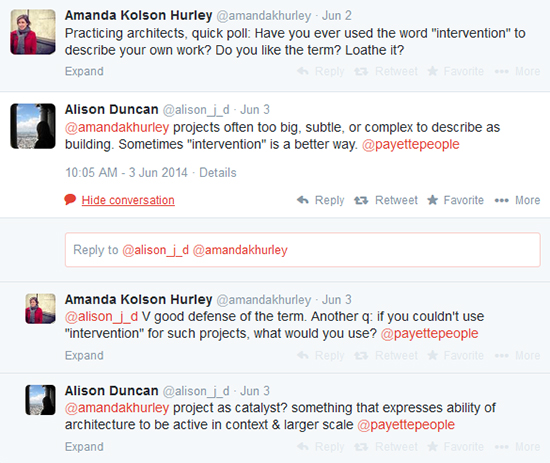This summer writer Amanda Kolson Hurley took to Twitter and asked how architects use the word “intervention” and whether or not individual architects like the term.

I passed the call on to my colleagues through an internal forum and a range of interesting responses emerged. Hurley recently published her analysis of the situation [Architects, it’s time for an intervention] along with a Storify capturing responses and I wanted to share the discussion Hurley’s question prompted here at PAYETTE.
Greta
I am concerned about how the general public would react to the term intervention. Remember that the related verb is “intervene.” One who intervenes is generally someone who enters a bad situation with superior knowledge of how to fix it. I prefer to think of architecture as a profession where we collaborate and synthesize, and expect that these verbs would better resonate with non-architects.
Will
I believe any modification of the built environment can be described as an intervention. We inherit existing conditions and then operate on them. Webster defines it as “to become involved in something in order to have an influence on what happens.” If we didn’t do that we wouldn’t get paid. Some people might find the term too harsh – “an intervention” often means bad news in the context of a friend or loved one. But contractors show up to sites with bulldozers, jackhammers, etc … everything is forcibly shaped. Now, whether something is branded as an “intervention” is a different debate. If sensitivity is the spirit of the project then perhaps a “context-sensitive addition and restoration” will sound better to the client. If the roof of an existing structure is leaking like crazy, I think anything less than a “full scale intervention” would be a disappointment.
Jeff Z.
When I worked for Massimo Carmassi, nearly twenty years ago, he referred to most of his work as “interventions.” Mind you that the majority of the work was renovation / additions to culturally significant sites, such as libraries being inserted into ancient Roman ruins and other similar project types. The word “renovation” just didn’t fit. I would submit that we need to be careful using the word “interventions” when describing the majority of work, however certain projects might warrant its use. In any case it must be used sparingly.
Brian S.
I wondered how this term is perceived by individuals such our clients who might be “outside the Realm,” so a quick Google search of “intervention” helped clarify:
“Bud Light Needs a Brand Intervention”
“Poll: Ukrainians Want Freedom from Outside Intervention”
“Yoga can’t be considered routine intervention for patients”
“Woman granted intervention, put on probation”
Based on these titles, a fair definition for an intervention might be: A course-changing, life-saving or last-ditch effort to fix something. So, I guess I’m not sold on this term as a good word to describe what we do. For me personally, I would describe our work with terms like facilitating, instigating, enabling or capitalizing ahead of intervening.
Mark C.
I have become so accustomed to hearing and using “intervention” as part of the lexicon of architectural jargon, going back to my school days, that it really has no affect on me one way or another. What really galls me is the current over- and mis-use of the terms “curate” and “curator.”
Alison
I actually think that intervention is often a good word to use in describing what we do. It is an active term that implies that architecture is doing more to shape our environment than just sit there. Building doesn’t often cover the size, complexity or subtle of what our projects can achieve in their contexts. I replied to Amanda in defense of the use of intervention, and she challenged me to come up with another word I would use instead. I really couldn’t come up quickly with a word that as concisely covers the active way our projects can shape their environments. Does anyone else have a good word that they like to use?

Reading Hurley’s post I wonder if, ultimately, this is a question of “inside baseball.” When architects use the term “intervention,” who is the audience? When it’s other architects, is there an implied understanding in the flexibility of the term? And, if the audience isn’t other architects, shouldn’t broader understanding be the goal?


